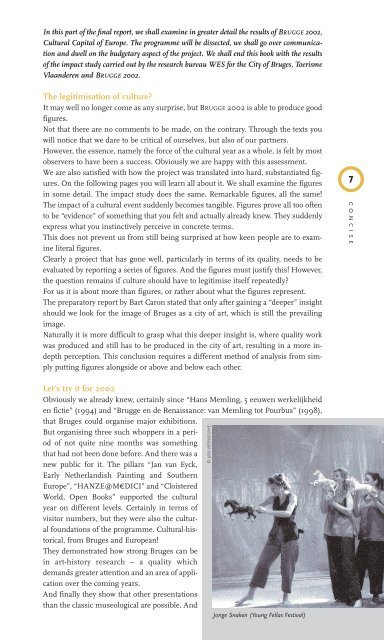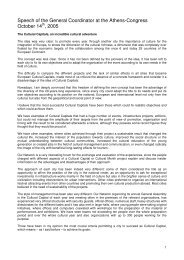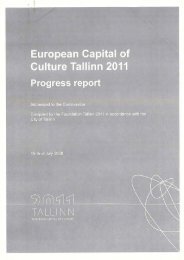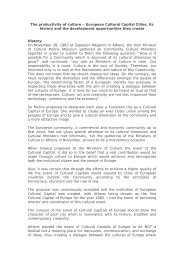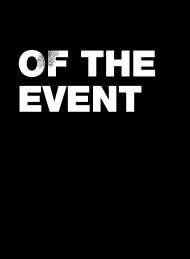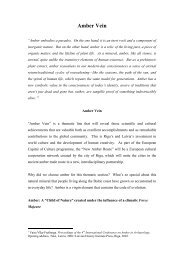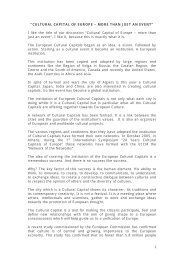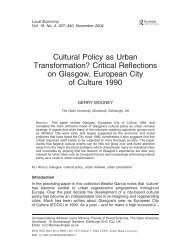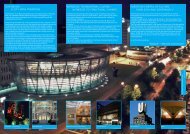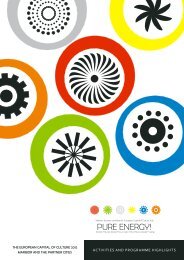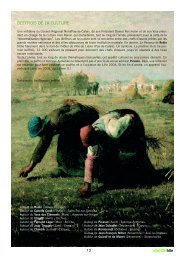Concise.pdf - Brugge Plus
Concise.pdf - Brugge Plus
Concise.pdf - Brugge Plus
- No tags were found...
Create successful ePaper yourself
Turn your PDF publications into a flip-book with our unique Google optimized e-Paper software.
In this part of the final report, we shall examine in greater detail the results of BRUGGE 2002,<br />
Cultural Capital of Europe. The programme will be dissected, we shall go over communication<br />
and dwell on the budgetary aspect of the project. We shall end this book with the results<br />
of the impact study carried out by the research bureau WES for the City of Bruges, Toerisme<br />
Vlaanderen and BRUGGE 2002.<br />
The legitimisation of culture<br />
It may well no longer come as any surprise, but BRUGGE 2002 is able to produce good<br />
figures.<br />
Not that there are no comments to be made, on the contrary. Through the texts you<br />
will notice that we dare to be critical of ourselves, but also of our partners.<br />
However, the essence, namely the force of the cultural year as a whole, is felt by most<br />
observers to have been a success. Obviously we are happy with this assessment.<br />
We are also satisfied with how the project was translated into hard, substantiated figures.<br />
On the following pages you will learn all about it. We shall examine the figures<br />
in some detail. The impact study does the same. Remarkable figures, all the same!<br />
The impact of a cultural event suddenly becomes tangible. Figures prove all too often<br />
to be “evidence” of something that you felt and actually already knew. They suddenly<br />
express what you instinctively perceive in concrete terms.<br />
This does not prevent us from still being surprised at how keen people are to examine<br />
literal figures.<br />
Clearly a project that has gone well, particularly in terms of its quality, needs to be<br />
evaluated by reporting a series of figures. And the figures must justify this! However,<br />
the question remains if culture should have to legitimise itself repeatedly<br />
For us it is about more than figures, or rather about what the figures represent.<br />
The preparatory report by Bart Caron stated that only after gaining a “deeper” insight<br />
should we look for the image of Bruges as a city of art, which is still the prevailing<br />
image.<br />
Naturally it is more difficult to grasp what this deeper insight is, where quality work<br />
was produced and still has to be produced in the city of art, resulting in a more indepth<br />
perception. This conclusion requires a different method of analysis from simply<br />
putting figures alongside or above and below each other.<br />
7<br />
CONCISE<br />
Let’s try it for 2002<br />
Obviously we already knew, certainly since “Hans Memling, 5 eeuwen werkelijkheid<br />
en fictie” (1994) and “<strong>Brugge</strong> en de Renaissance: van Memling tot Pourbus” (1998),<br />
that Bruges could organise major exhibitions.<br />
But organising three such whoppers in a period<br />
of not quite nine months was something<br />
that had not been done before. And there was a<br />
new public for it. The pillars “Jan van Eyck,<br />
Early Netherlandish Painting and Southern<br />
Europe”, “HANZE@M4DICI” and “Cloistered<br />
World, Open Books” supported the cultural<br />
year on different levels. Certainly in terms of<br />
visitor numbers, but they were also the cultural<br />
foundations of the programme. Cultural-historical,<br />
from Bruges and European!<br />
They demonstrated how strong Bruges can be<br />
in art-history research – a quality which<br />
demands greater attention and an area of application<br />
over the coming years.<br />
And finally they show that other presentations<br />
than the classic museological are possible. And<br />
Jonge Snaken (Young Fellas Festival)<br />
© JAN VERNIEUWE


